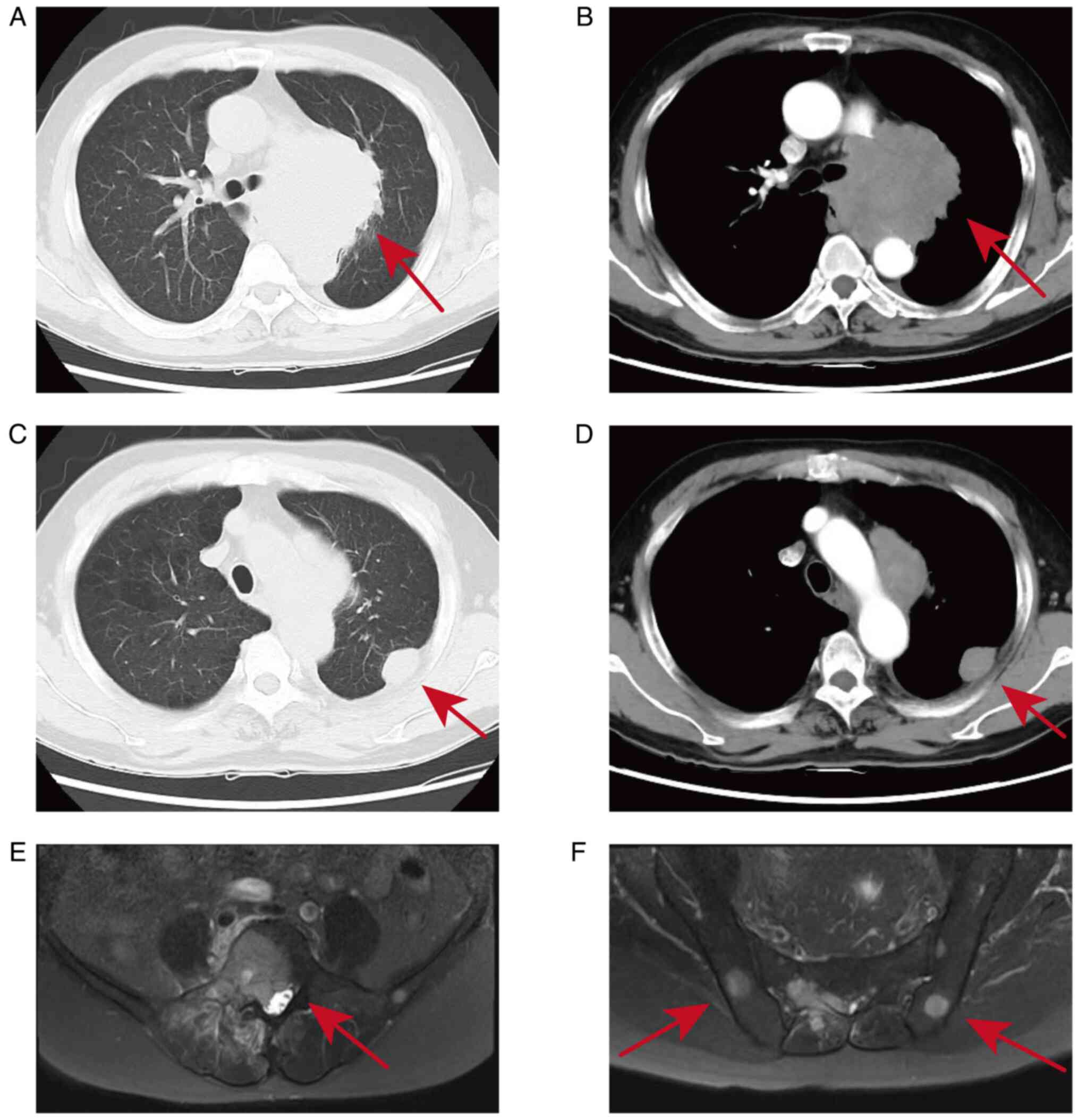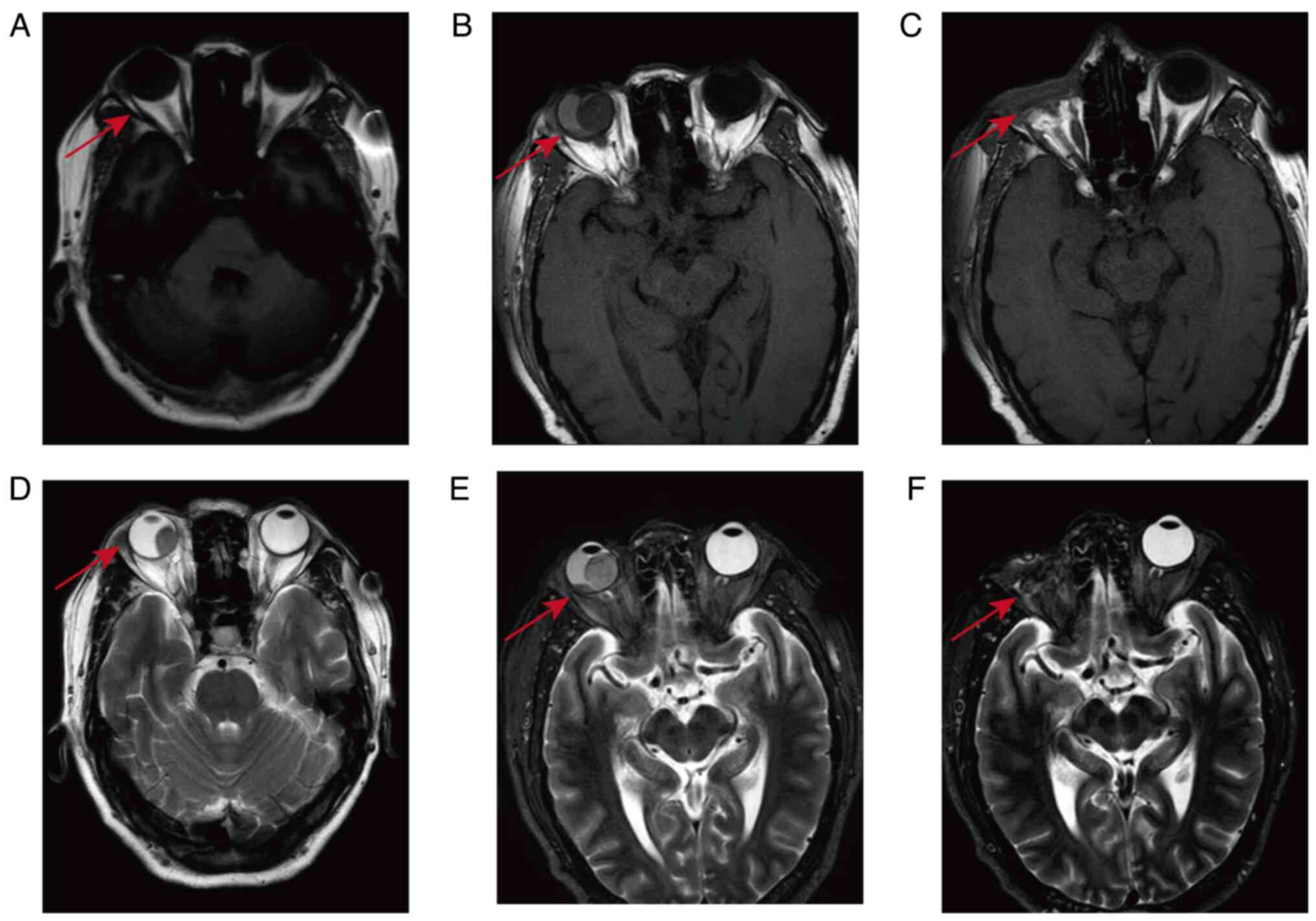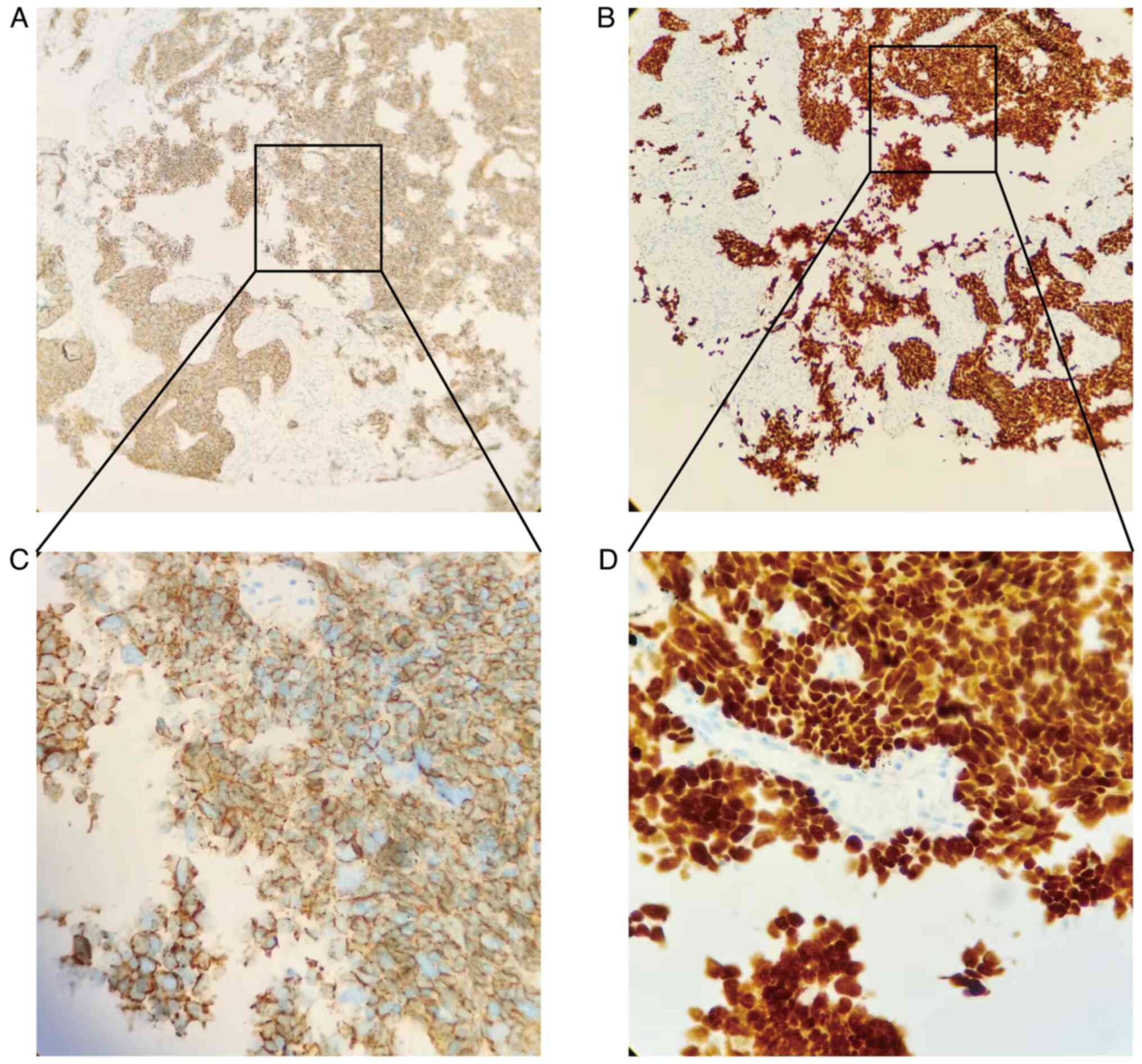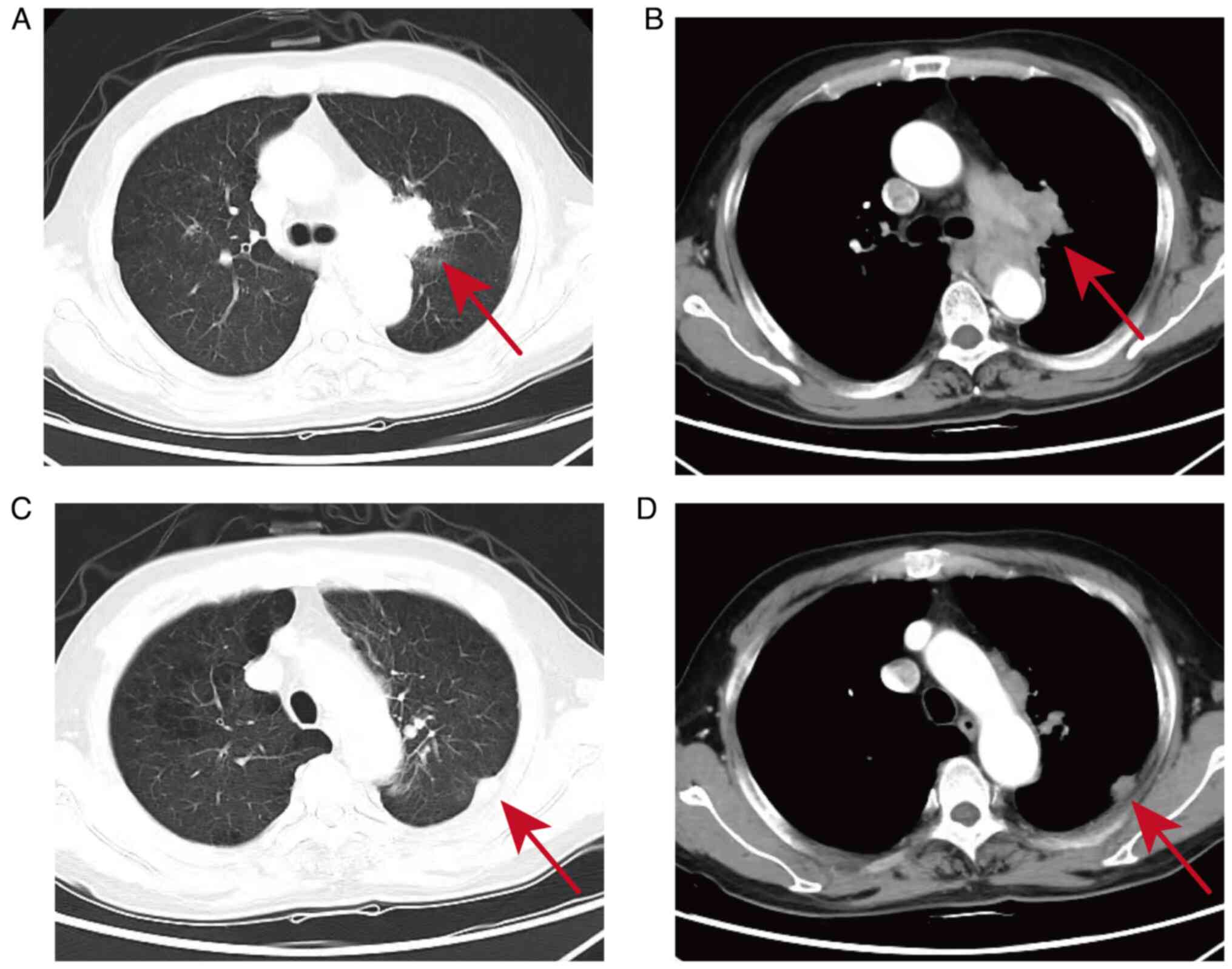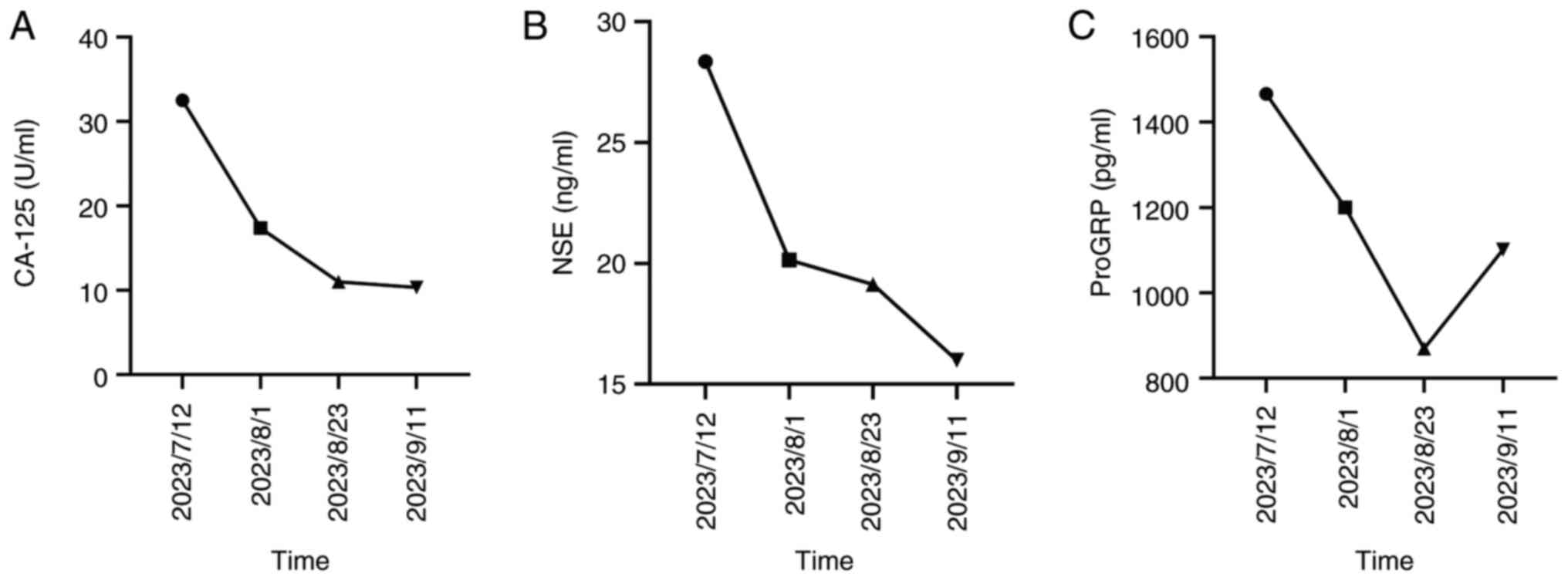Right eye metastasis of small‑cell lung carcinoma: A case report
- Authors:
- Published online on: June 14, 2024 https://doi.org/10.3892/etm.2024.12607
- Article Number: 318
-
Copyright: © Zhu et al. This is an open access article distributed under the terms of Creative Commons Attribution License.
Abstract
Introduction
Lung carcinoma is one of the most common malignant tumors in China, with an incidence rate that ranks second in the country; moreover, it has a mortality rate that ranks first globally (1). Lung carcinoma is classified into non-small-cell lung carcinoma (NSCLC) and small-cell lung carcinoma (SCLC), of which SCLC accounts for ~15% of lung carcinomas (2). SCLC is characterized by a high proliferation rate, a tendency for early metastasis and a poor prognosis (3). Most patients with SCLC have already developed distal metastasis at the time of diagnosis. Intraocular tumors can threaten the patient's vision and even life. Moreover, symptoms of ocular metastatic carcinoma can be the same or similar to symptoms of the primary tumor (4). Therefore, ocular metastatic carcinoma is easily overlooked, making accurate diagnosis and treatment more crucial. Case reports regarding eye metastasis in SCLC indicate that right-sided eye metastasis is rare (5). The present study reported a case of SCLC with right-sided eye metastasis. It gives a comprehensive report of the patient's treatment process, in order to provide a reference for the clinical diagnosis and treatment of ocular metastatic carcinoma.
Case presentation
A 54-year-old male patient presented with right flank pain and limited mobility of the right lower limb, accompanied by numbness, which began in April 2023. In June 2023, the patient was treated at Lu'an Hospital, which is affiliated with Anhui University of Chinese medicine (Anhui, China). A lumbar magnetic resonance imaging (MRI) scan indicated a high possibility of bone metastasis (Fig. 1E and F). A further contrast-enhanced chest computed tomography (CT) revealed a malignant lesion at the hilum of the left lung with pleural metastases (Fig. 1A and B). Cranial MRI suggested a possible metastatic lesion in the right eye (Fig. 2A and D). The patient underwent a pulmonary tissue biopsy and subsequent immunohistochemical staining.
The lung tissue was immersed in 4% neutral formalin at 37˚C for 24 h. It was then dehydrated with different concentrations of ethanol and finally embedded in paraffin. A 4 µm tissue section adhering to the glass slide was baked in a 60˚C oven for 1.5 h. Subsequently, an immunohistochemical experiment was conducted using the Roche BenchMark XT fully automated immunohistochemical instrument (Roche Diagnostics). Detailed operational procedures were as follows: Heat dewaxing was performed using EZ Prep (dehydrating solution, 1:10, lot number: K14102; Roche Diagnostics). Then, CC1 (alkaline repair solution, pH 8.0-8.5, lot number: 77307801; Roche Diagnostics) was applied at 100˚C for a given period of time (depending on the type of antibody), with an increase in heating time of 8 min and a cooling time of 7 min. Blocking was performed using a UV Inhibitor (hydrogen peroxide, lot number: K13635-K13800; Roche Diagnostics) for 4 min. A primary antibody was added and the mixture incubated for a specified period of time. The antibodies with an antigen retrieval time of 36 min included: CD56 (rabbit monoclonal, cat. no. IR040; incubation time: 36 min), CK5/6 (mouse monoclonal, lot no. IM060; incubation time: 36 min), NapsinA (mouse monoclonal, cat. number: IM198; incubation time: 40 min), Ki-67 (rabbit monoclonal, lot number: IR098; incubation time: 40 min). The antibodies with an antigen retrieval time of 64 min included: P40 (rabbit monoclonal, lot number: IR345; incubation time: 36 min), TTF-1 (rabbit monoclonal, lot no. IR301; incubation time: 36 min), CgA (mouse monoclonal, lot number: IM053; incubation time: 40 min), LCA (mouse monoclonal, lot number: IM038; incubation time: 40 min) (all antibodies were stock solutions from Abcam; temperature was 37˚C). The UV HRP-Multimer (the second antibody, comprising HRP-labeled goat anti-mouse IgG, goat anti-mouse IgM and goat anti-rabbit antibodies, ~55 µg/ml, lot number: K13635-K13799; Roche Diagnostics) was added to the mixture and incubate for 8 min. UV DAB (3,3'-diaminobenzidine reagent; lot number: K13635-K13802; Roche Diagnostics) and UV H2O2 (phosphate buffer solution containing 0.04% hydrogen peroxide, lot number: K13635-K13803; Roche Diagnostics) were added and incubate for 8 min. UV Copper (an enhancer containing 5 g/l copper sulfate, lot number: K13635-K13805; Roche Diagnostics) was added and incubate for 4 min. Hematoxylin Ⅱ (lot number: K14384; Roche Diagnostics) was added and incubated for 12 min. bluing reagent (lot number: K12265; Roche Diagnostics) was added and incubated for 4 min. Upon completion, The tissue sections on the slides were dehydrated, mounted in a neutral resin and then imaged using an optical microscope.
Based on the results of lung histopathology (Fig. 3) and immunohistochemistry (IHC; Fig. 4A-D) and after ruling out other neuroendocrine tumors, the patient was diagnosed with SCLC of the left lung, stage T4N1M1c, IVB. The patient did not have a family history of hereditary diseases. The patient is divorced and has one daughter. The patient has been smoking for >30 years.
Starting in June 2023, the patient was treated with enverolumab and etoposide and cisplatin every three weeks as a course of treatment: Enverolumab 400 mg subcutaneously on day 1; Etoposide 120 mg intravenously on days 1-3; and Cisplatin 30 mg intravenously on days 1-3. In July 2023, after one course of treatment, the patient experienced decreased and blurred vision in both eyes. The ophthalmological consultation indicated that the intraocular pressure of both eyes was as follows: Right/left: 16/18 mmHg. Right fundus photography (Fig. 5A) and right eye ultrasound (Fig. 5B-C) showed a space-occupying lesion in the vitreous chamber and retinal detachment in the right eye. The treatment plan primarily focused on systemic therapy. In August 2023, after two courses of treatment, the patient experienced pain in the right eye. The ophthalmologic consultation indicated an intraocular pressure of 32 mmHg in the right eye. The contrast-enhanced MRI of the orbits showed abnormal enhancement signals and a detached state of the retinal membrane on the right eyeball (Fig. 2B and E). At 4 days later, there was significant conjunctival congestion in the right eye (Fig. 6A and B). Within a week, the patient reported experiencing total blindness in the right eye and the oral oxycodone dose was rapidly increased to 40 mg every 12 h (q12h). Following consultations with a multiple disciplinary team (MDT), it was decided not to opt for ocular radiation treatment due to the absence of visual acuity in the right eye. Even if radiation therapy proved to be effective, visual acuity could not be restored. Later in August 2023, the patient underwent enucleation of the right eyeball. This was performed at the 901 Hospital of the People's Liberation Army of China, which is located in Hefei, Anhui (China). The patient provided the hospital's postoperative pathology and immunohistochemical results. Postoperative pathology revealed a small-cell malignant tumor in the right eyeball (Pathology Report Number: 2306821). When the patient's IHC results were examined in combination with the medical history, there was a tendency for pulmonary small-cell metastasis to the right eyeball. The tumor measured 2x2x1.3 cm and invaded the retina and choroid, but not the sclera. IHC (23-506) results were as follows: TTF-1(-), P40(-), Syn(+), NapsinA(-), CD56(+) and CgA(-). The Ki-67 hotspot area covered ~70%. The patient continued to be treated at Lu'an Hospital (Anhui, China). The postoperative recovery of the eye was good (Fig. 6C). After four courses of treatment, a contrast-enhanced MRI of the orbits was performed in September 2023. This showed the absence of the right eyeball, with no metastatic lesions in the left eye (Fig. 2C and F). In October 2023, by the sixth course of treatment, the contrast-enhanced chest CT showed that the hilar and pleural metastatic lesions had reduced in size compared to June (Fig. 7A-D). During the treatment period, the levels of carbohydrate antigen 125 (CA-125), neuron-specific enolase (NSE) and progastrin-releasing peptide (ProGRP) decreased (Fig. 8). In addition, the demonstrated vertebral metastases were treated with radiotherapy (30 Gy/10 fractions). Currently, the condition of the patient is stable, with ongoing oral administration of anlotinib (12 mg qd). In addition, follow-up visits are continuing.
Discussion
SCLC is a high-grade neuroendocrine carcinoma (6). It is an aggressive smoking-related malignancy characterized by rapid growth and early metastatic spread (7). Depending on the extent of tissue involvement, SCLC is generally divided into limited period and extensive stages (8). The extensive stage accounts for ~70% of SCLC cases (9), with the most common sites of metastasis being the brain, liver, or bone (10). There are also reports of ocular metastasis from SCLC (11).
Intraocular tumors are classified into primary and metastatic tumors. Metastatic tumors in the eye can originate from various tissues and organs throughout the body. The most common primary tumor sites that lead to intraocular metastasis are the breasts (40-47%) and lungs (21-29%) (12). Additionally, primary tumors in other locations can also metastasize to the eye, such as the kidney (13), stomach (14) and pancreas (15).
The eyes lack a lymphatic system, with most eye metastatic tumors arising from hematogenous spread (16). Metastatic tumors in the eye mainly occur in the uveal tissue due to its abundant blood supply and multiple vascular connections, with the choroid being the most frequent location (17). Intraocular metastatic tumors are relatively rare (18). The ophthalmic artery branches at a right angle to the internal carotid artery. This anatomical feature increases the likelihood of tumor emboli in the bloodstream getting lodged within the intracranial cavity due to the rapid blood flow. Consequently, these emboli are less likely to enter the eye through the ophthalmic artery. The incidence of intraocular metastases to the left eye may be slightly higher, based on anatomical characteristics (19). That is, the bloodstream of the right eye must bypass the innominate artery to travel upward, whereas the left common carotid artery can directly ascend into the left eye.
The most common ocular symptoms of intraocular metastasis are blurred vision and loss of vision (20). These often occur due to invasion of the macular area or the area around the optic disc, leading to subretinal exudation which causes retinal detachment. Other symptoms include eye pain, floating objects in the vision, visual field defects, abnormal eye position, proptosis, increased orbital pressure, diplopia and restricted eye movement.
The ocular manifestations of metastatic tumors may serve as the initial symptoms of the primary tumor (21-23). Misdiagnosis or missed diagnosis of eye metastases may lead to rapid deterioration of the condition. If detected late, it may invade the contralateral optic nerve along the orbital floor, leading to bilateral vision loss and potentially blindness (24-26). Within the clinical literature, there are cases of ocular metastatic carcinomas misdiagnosed as secondary glaucoma, leading to vision loss and the need for enucleation of the eyeball (27). Therefore, for patients suspected of having metastatic carcinoma in the eye, early diagnosis is crucial. This can be achieved through a comprehensive evaluation of the patient's signs and symptoms, as well as necessary auxiliary examinations, to formulate an appropriate treatment plan.
Clinical manifestations serve as the basis for the early diagnosis of eye metastases. If a patient shows signs of suspected malignant tumors in the eyes, an immediate examination should be conducted to identify potential orbital metastases. Diagnostic confirmation can be achieved through a comprehensive array of modalities, including: funduscopy, ocular ultrasound, optical coherence tomography (OCT), fundus fluorescence angiography (FFA), indocyanine green angiography, CT, MRI and, when necessary, histopathological examination via fine-needle aspiration biopsy (FNAB) (28).
The treatment for intraocular metastatic tumors primarily involves systemic and localized therapies (29). However, systemic treatment often leads to secondary resistance. For eye metastases, local treatment is recommended either concurrently or following systemic therapy (30). Radiation therapy is the primary localized treatment for eye metastases (31). Ocular radiation therapy can eradicate localized tumors, control pain and improve vision. Specifically, studies have indicated that in a group of 15 patients (19 eyes) who underwent reflexotherapy, 11 out of 13 (84.6%) showed improvement in vision and 14 out of 15 (93.3%) experienced partial or complete remission (CR) of their ocular tumors (32). When the ocular metastatic carcinoma causes severe pain or discomfort that cannot be alleviated by medication or other conservative treatments and the eyeball loses its normal function, enucleation of the eyeball may be performed.
The use of enverolumab as a treatment was based on the protocol provided by the Cancer Hospital, which is affiliated with the Fudan University in Shanghai, China. After patient consultation, the patient's family requested the use of this protocol. According to the Chinese Society of Clinical Oncology guidelines, enverolumab is not recommended as a first-line treatment for extensive small cell lung carcinoma (ES-SCLC). However, a review of relevant literature revealed clinical studies on the use of a combination of enverolumab with carboplatin/cisplatin and etoposide as a first-line treatment for ES-SCLC (33). Therefore, the hospital's recommendation was followed and this protocol was accordingly implemented.
In the present case, the patient experienced a sudden loss of vision and intense pain in the right eye within a short period of time. Upon examination using funduscopy, ophthalmic ultrasound, OCT and eye MRI, a metastatic lesion was suspected. After MDT consultations, surgical extraction was chosen. Postoperatively, the patient's pain and quality of life improved markedly. Systemic treatment using immunotherapy combined with chemotherapy resulted in a decrease in lung lesions. However, eyeball extraction is a destructive procedure that should be performed cautiously when multiple lines of evidence are established. If possible, hospitals should conduct multidisciplinary discussions. If the patient's eye pain is not severe, local radiation therapy should be the first choice. Early diagnosis and treatment of the ocular metastatic carcinoma can help control tumor spread, preserve vision and improve the patient's quality of life. When clinical symptoms suggest a suspected malignant tumor in the eye, a comprehensive cancer investigation should be conducted using funduscopy, ophthalmic ultrasound, OCT, FFA, CT, MRI and FNAB. Timely and appropriate treatment should be provided to preserve the patient's vision as much as possible and manage the growth of intraocular tumors.
Acknowledgements
Not applicable.
Funding
Funding: No funding was received.
Availability of data and materials
The data generated in the present study are included in the figures and/or tables of this article.
Authors' contributions
QS developed a clear treatment plan for patients with SCLC. During the treatment WD collected detailed cases. MW collated the patients' cases and pictures. PZ collected relevant literature, wrote, translated and refined the manuscript. Finally, all individuals checked the data and completed this article. PZ and WD confirm the authenticity of all the raw data. All authors read and approved the final manuscript.
Ethics approval and consent to participate
Not applicable.
Patient consent for publication
The patient's written consent has been obtained.
Competing interests
The authors declare that they have no competing interests.
References
|
Huang J, Deng Y, Tin MS, Lok V, Ngai CH, Zhang L, Lucero-Prisno DE III, Xu W, Zheng ZJ, Elcarte E, et al: Distribution, risk factors, and temporal trends for lung cancer incidence and mortality: A global analysis. Chest. 161:1101–1111. 2022.PubMed/NCBI View Article : Google Scholar | |
|
Cozzi S, Bruni A, Ruggieri MP, Borghetti P, Scotti V, Franceschini D, Fiore M, Taraborrelli M, Salvi F, Galaverni M, et al: Thoracic radiotherapy in extensive disease small cell lung cancer: Multicenter prospective observational TRENDS study. Cancers (Basel). 15(434)2023.PubMed/NCBI View Article : Google Scholar | |
|
Xie Q, Chu H, Yi J, Yu H, Gu T, Guan Y, Liu X, Liang J, Li Y and Wang J: Identification of a prognostic immune-related signature for small cell lung cancer. Cancer Med. 10:9115–9128. 2021.PubMed/NCBI View Article : Google Scholar | |
|
Shamim S, Vidya S, Kabir S and Ghosh B: Choroidal metastases as the initial presentation of lung cancer: A rare scenario. Niger J Clin Pract. 20:905–909. 2017.PubMed/NCBI View Article : Google Scholar | |
|
Sakellakis M, Peroukides S, Iconomou G and Kalofonos H: Iris metastasis in a patient with small cell lung cancer: A case report. Iran Red Crescent Med J. 18(e21522)2016.PubMed/NCBI View Article : Google Scholar | |
|
Al Zreibi C, Gibault L, Fabre E and Le Pimpec-Barthes F: Chirurgie du cancer pulmonaire à petites cellules Surgery for small-cell lung cancer. Rev Mal Respir. 38:840–847. 2021.(In French). | |
|
Lally BE, Urbanic JJ, Blackstock AW, Miller AA and Perry MC: Small cell lung cancer: Have we made any progress over the last 25 years? Oncologist. 12:1096–1104. 2007.PubMed/NCBI View Article : Google Scholar | |
|
Konala VM, Madhira BR, Ashraf S and Graziano S: Use of immunotherapy in extensive-stage small cell lung cancer. Oncology. 98:749–754. 2020. | |
|
Melosky B, Cheema PK, Brade A, McLeod D, Liu G, Price PW, Jao K, Schellenberg DD, Juergens R, Leighl N and Chu Q: Prolonging survival: The role of immune checkpoint inhibitors in the treatment of extensive-stage small cell lung cancer. Oncologist. 25:981–992. 2020.PubMed/NCBI View Article : Google Scholar | |
|
Vicini G, Nicolosi C, Pieretti G and Mazzini C: Large choroidal metastasis with exudative retinal detachment as presenting manifestation of small cell lung cancer: A case report. Respir Med Case Rep. 30(101074)2020.PubMed/NCBI View Article : Google Scholar | |
|
Karunanithi S, Sharma P, Jain S, Mukherjee A and Kumar R: Iris metastasis in a patient with small cell lung cancer: Incidental detection with 18F-FDG PET/CT. Clin Nucl Med. 39:554–555. 2014.PubMed/NCBI View Article : Google Scholar | |
|
Arepalli S, Kaliki S and Shields CL: Choroidal metastases: Origin, features, and therapy. Indian J Ophthalmol. 63:122–127. 2015.PubMed/NCBI View Article : Google Scholar | |
|
Shome D, Honavar SG, Gupta P, Vemuganti GK and Reddy PV: Metastasis to the eye and orbit from renal cell carcinoma-a report of three cases and review of literature. Surv Ophthalmol. 52:213–223. 2007.PubMed/NCBI View Article : Google Scholar | |
|
Sitaula R, Shrestha GB, Paudel N and Shrestha JK: Ocular and orbital metastases presenting as a first sign of gastric adenocarcinoma. BMJ Case Rep. 2011(bcr1020114927)2011.PubMed/NCBI View Article : Google Scholar | |
|
Singh A, Malik D, Singh S and Vyas VJ: Choroidal metastasis in pancreatic adenocarcinoma. J Cancer Res Ther. 18:263–265. 2022.PubMed/NCBI View Article : Google Scholar | |
|
Cohen VM: Ocular metastases. Eye (Lond). 27:137–141. 2013.PubMed/NCBI View Article : Google Scholar | |
|
Cennamo G, Montorio D, Carosielli M, Romano MR and Cennamo G: Multimodal imaging in choroidal metastasis. Ophthalmic Res. 64:411–416. 2021.PubMed/NCBI View Article : Google Scholar | |
|
Funazo T, Morita K, Ikegami N, Konishi C, Nakao S, Ariyasu R, Taki M, Nakagawa K, Hwang MH, Yoshimura C, et al: Successful treatment with alectinib for choroidal metastasis in anaplastic lymphoma kinase rearranged non-small cell lung cancer. Intern Med. 56:2317–2320. 2017.PubMed/NCBI View Article : Google Scholar | |
|
Ahmad SM and Esmaeli B: Metastatic tumors of the orbit and ocular adnexa. Curr Opin Ophthalmol. 18:405–413. 2007.PubMed/NCBI View Article : Google Scholar | |
|
Konstantinidis L and Damato B: Intraocular metastases-a review. Asia Pac J Ophthalmol (Phila). 6:208–214. 2017.PubMed/NCBI View Article : Google Scholar | |
|
Das SK, Sahoo TK, Parija S, Majumdar SKD and Parida DK: Choroidal metastasis as initial presentation in adenocarcinoma of lung: A case report. J Clin Diagn Res. 11:XD04–XD06. 2017.PubMed/NCBI View Article : Google Scholar | |
|
Migaou A, Ben Saad A, Joobeur S, Ben Abdeljelil N, Zina S, Cheikh Mhammed S, Rouatbi N and Fahem N: Choroidal metastasis as the initial presentation of lung adenocarcinoma: A case report. Respir Med Case Rep. 29(100992)2020.PubMed/NCBI View Article : Google Scholar | |
|
Zhou Y, Sharifi A, Gupta P, Duong B, Lahiji AP, He J and Lee WH: Vision loss as presenting symptom in testicular cancer: A morbid case report. Case Rep Ophthalmol. 13:756–762. 2022.PubMed/NCBI View Article : Google Scholar | |
|
Cun LP: MRI-based radiomics on prediction of lymph-vascular space invasion in cervical cancer. Chin Med Sci University, 2021. | |
|
Wu L, Yan J, Bai Y, Chen F, Zou X, Xu J, Huang A, Hou L, Zhong Y, Jing Z, et al: An invasive zone in human liver cancer identified by Stereo-seq promotes hepatocyte-tumor cell crosstalk, local immunosuppression and tumor progression. Cell Res. 33:585–603. 2023.PubMed/NCBI View Article : Google Scholar | |
|
Zhou ZY, Wang Y, Long SY, et al: Research progress on the pathogenesis of tumor-induced or infiltrative optic neuropathy and traditional Chinese medicine etiology and pathogenesis. China J Chinese Ophthalmol. 33:785–788. 2023. | |
|
Yang M, Wang W, Yan JH, Li XY, Zhou MW, Huang WB and Zhang XL: Eye tumors misdiagnosed as glaucoma. Chin Med J. 128:273–276. 2015.PubMed/NCBI View Article : Google Scholar | |
|
Rishi P, Dhami A and Biswas J: Biopsy techniques for intraocular tumors. Indian J Ophthalmol. 64:415–421. 2016.PubMed/NCBI View Article : Google Scholar | |
|
Paul Chan RV and Young LH: Treatment options for metastatic tumors to the choroid. Semin Ophthalmol. 20:207–216. 2009.PubMed/NCBI View Article : Google Scholar | |
|
Thariat J, Boudin L, Loria O, Nguyen AM, Kodjikian L and Mathis T: How to manage a patient with ocular metastases? Biomedicines. 10(3044)2022.PubMed/NCBI View Article : Google Scholar | |
|
Cho KR, Lee KM, Han G, Kang SW and Lee JI: Gamma knife radiosurgery for cancer metastasized to the ocular choroid. J Korean Neurosurg Soc. 61:60–65. 2018.PubMed/NCBI View Article : Google Scholar | |
|
Chik JYK, Leung CWL and Wong KH: Palliative radiation therapy for patients with orbital and ocular metastases. Ann Palliat Med. 9:4458–4466. 2020.PubMed/NCBI View Article : Google Scholar | |
|
Zhao L, Long L, Liang X, et al: Clinical research progress of PD-L1 inhibitor envafolimab in the treatment of advanced malignant tumor. Journal of Modern Oncology. 32:1154–1158. 2024. |



